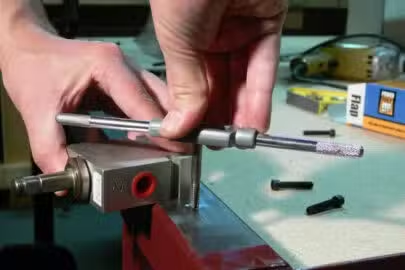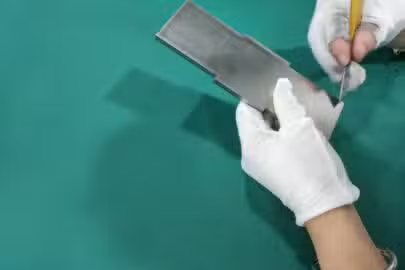CNC machining is a method of manufacturing things that includes the use of multiple tools, each of which has a specific purpose. However, there is frequently a misunderstanding between two distinct tools: the jig and the fixture. Although functionally separate, the phrases “jig” and “fixture” are commonly used interchangeably. Despite their similar roles, they provide distinct functions.
Jigs are devices that hold a cutting tool in place or guide its movement during repetitive operations like drilling or tapping holes. Fixtures, on the other hand, do not guide cutting tools; rather, they maintain the stability of a workpiece at a particular position, orientation, or location.
This article will explain the differences and similarities between jigs and fixtures. By the conclusion, you’ll have a strong understanding of what jigs and fixtures are used for. Are you ready to dive into the realm of knowledge? Let’s get started!
What are Jigs?
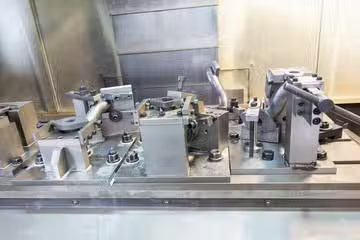
Jigs are essential equipment for anchoring a workpiece as well as a machine part to a workstation. It is attached to CNC machine tools, such as lathe cutting tools, and it is crucial in detecting the precise location and motion of these tools. A jig basically serves as a guide for the machining equipment. Jigs are distinguished by one feature: when in motion, the tool remains stationary.
Jigs are no longer required due to the growth of automation and computer numerically controlled (CNC) machinery. The digital programming and storage of tool paths in the machine’s memory is credited with this transition. However, in smaller machine shops, jigs retain their relevance. They play a vital role in facilitating the manual machining of unique or custom parts, especially in the production of one-off items.
Types of Jigs
In CNC machining, jigs are readily accessible tools, manifesting in a variety of types. Below are some common types of jigs employed in machining processes:
Template Jigs
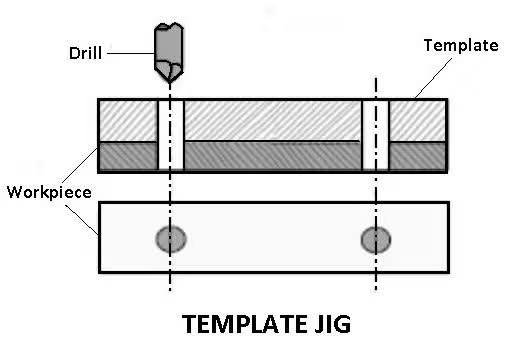
Characterized by simplicity and renowned for their accuracy, these jigs are not only swift but are primarily valued for their precision over speed by machinists. Template jigs find versatile applications, whether fitted over or into the workpiece. It’s noteworthy that these jigs typically do not involve clamping.
Angle-Plate Jigs
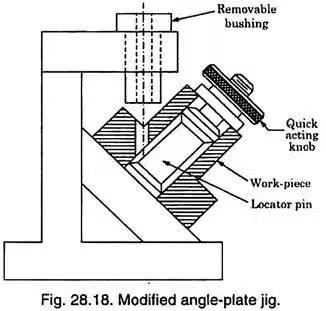
For securing drill-ready parts at an angle to their mounting locators, the angle-plate jig is an optimal choice. In cases where the machining angle surpasses 90°, a modified angle plate jig is employed to meet the specific requirements.
Plate Jigs
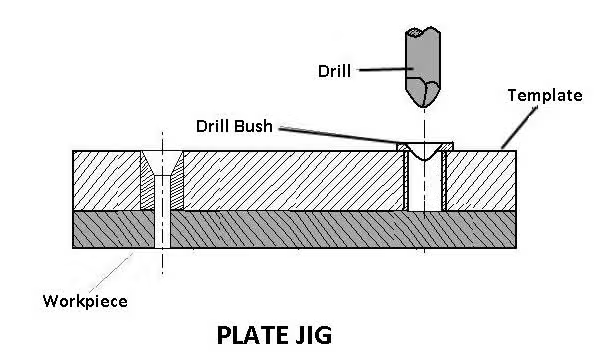
Plate jigs share similarities with template jigs in terms of functionality. However, in contrast to template jigs, plate jigs are equipped with built-in clamps designed to secure the workpiece. Additionally, plate jigs may be configured with or without bushings, offering versatility in their applications.
Leaf Jigs
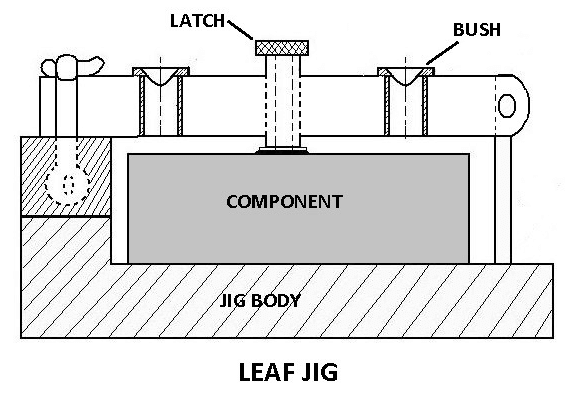
This specific type of jig is essentially a compact box jig with short or latched hinged limbs, facilitating the seamless loading and unloading of parts. Importantly, the hinged leaf in this configuration does not fully encircle the part.
Channel Jigs
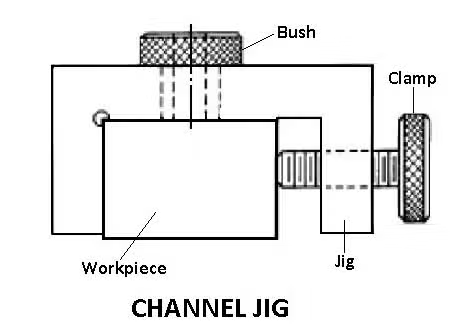
The channel jig stands out for its uncomplicated design, featuring a cross-section resembling a channel. The components neatly fit into this channel, allowing precise location and secure clamping achieved by turning the knurled knob. Notably, the tool can be guided through the drill bush for accurate machining.
Box Jigs
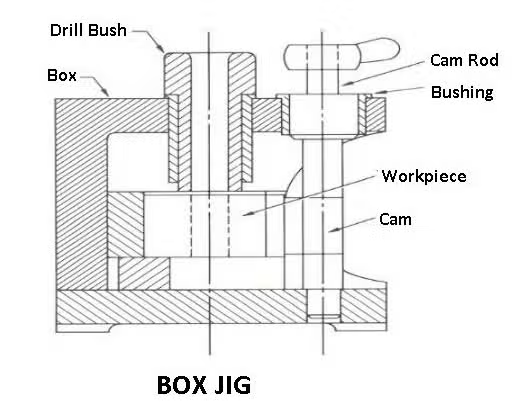
A box jig takes the form of a box-like structure, tightly enclosing the work within. This configuration enables the drilling or machining of the work from various angles in a single setup. The specific face of the jig turned toward the tool determines the angle of operation.
What are Fixtures?
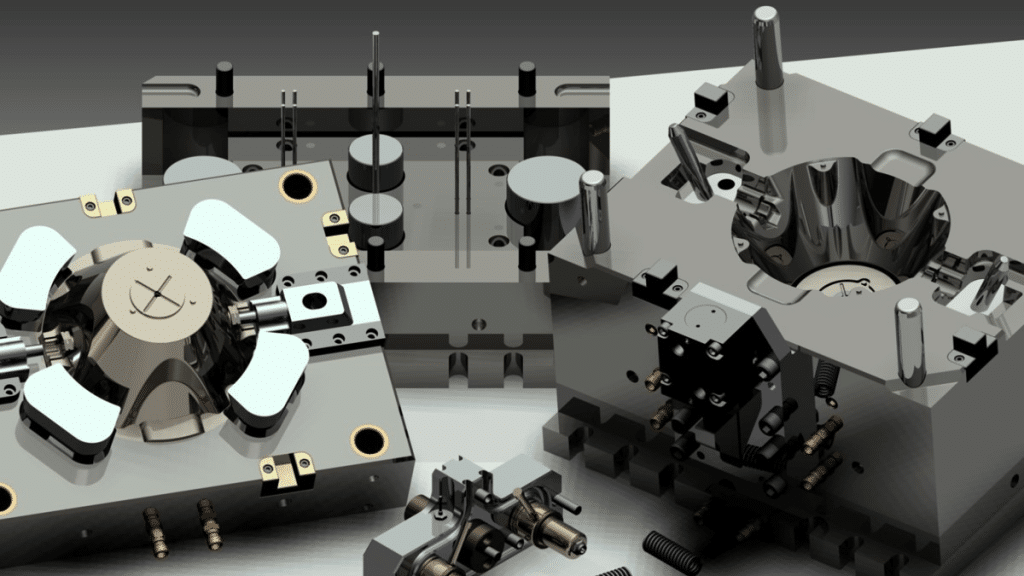
Fixtures are equipment used to securely and precisely anchor a workpiece on the machine bed. Fixtures ensure accuracy and repeatability in machining processes by maintaining total stability. Furthermore, they may be adjusted to hold a workpiece at particular angles, simplifying cutting operations in a variety of orientations. Fixtures play an important role in contributing to a safer working environment by decreasing errors and preventing workpieces from accidentally dislodging from the work table.
Fixtures are widely used in a variety of machining techniques such as milling, turning, planing, slotting, and grinding. They are also essential in multidimensional machining, automotive vehicle assembly, and optical and laser scanning inspection systems. Notable examples are a material block tightly secured inside a CNC machine and a vise positioned on a workbench, both of which serve as fixtures. Fixtures are critical in the context of vehicle assembly lines for fastening and directing cars through welding and assembly operations.
Types of Fixtures
Many machinists may find themselves less acquainted with the classification of fixtures, leading to challenges in selecting the most suitable one for their operations. Based on their function, fixtures can be categorized into different types:
Turning Fixtures
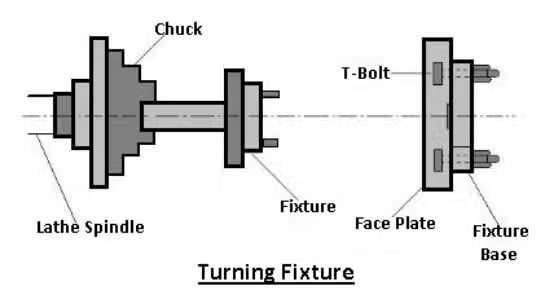
Turning fixtures are commonly affixed to the machine spindle’s nose or a faceplate. In certain instances, it might be necessary to equip the fixture with a counterweight to balance any unevenness. Generally applied to the production of intricate lathe-made components, turning fixtures play a crucial role in ensuring precision and stability during the turning process.
Milling Fixtures
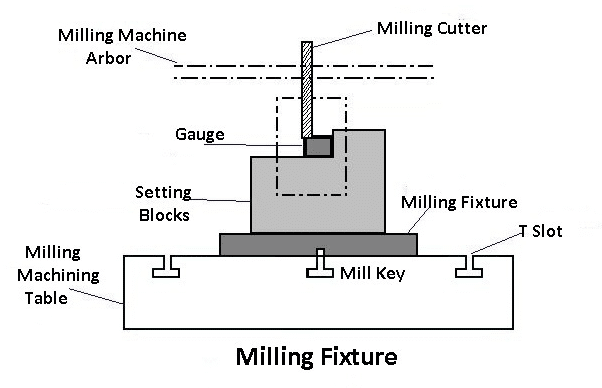
Milling fixtures are typically secured to the machine spindle’s nose or a faceplate, anchored by the workpieces themselves. The table is carefully adjusted and positioned around the cutter. Before commencing the machining process, the workpieces are positioned within the base of the fixture and securely clamped in place.
Broaching Fixtures
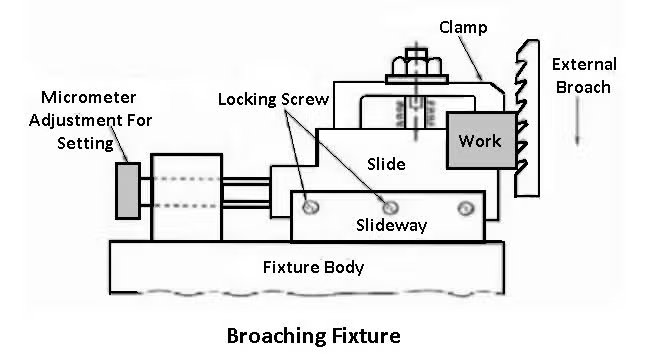
Frequently employed on various broaching machines, broaching fixtures play a crucial role in locating, securing, and supporting workpieces throughout operations. Keyway broaching, encompassing tasks like keyway broaching and hole broaching, serves as an illustrative example of operations facilitated by these fixtures.
Indexing Fixtures
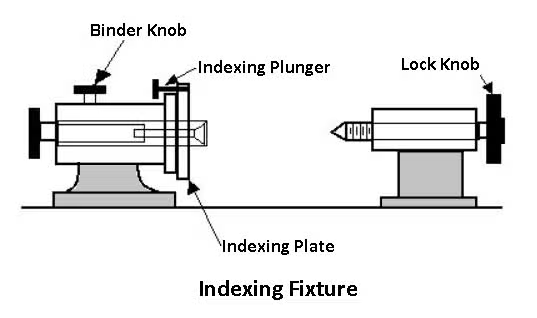
When machining multiple components with surfaces or shapes that need uniform spacing, the elements must be indexed to match the number of surfaces to be machined. Holding devices, such as jigs or fixtures, are specifically crafted to incorporate an indexing mechanism. An indexing fixture is a fixture equipped with such a device, facilitating the precise alignment and machining of components with multiple surfaces.
Differences between a Jig and a Fixture
Jigs and fixtures are frequently considered synonymous, and at times, the combined term “jig fixtures” is used. Despite their interchangeable use, these terms serve distinct functions in the mass production process. Let’s explore some of the differences between jigs and fixtures:
| Differences | Jigs | Fixtures |
| Primary Function | A jig is designed to guide the cutter to operate at a predetermined location on a workpiece, providing both support and location for the part. | A fixture is focused on securing, supporting, and locating the workpiece, without guiding the machine part itself. |
| Weight | Generally, jigs tend to be lighter compared to fixtures. | Fixtures are subjected to substantial cutting forces and vibrations, thus to be heavier and more robust to withstand these challenging conditions effectively. |
| Construction and Clamping | Jigs are typically lighter in build, and frequently, clamping to the table may not be necessary. | Fixtures are characterized by a heavier construction and are firmly bolted onto machine tables to ensure rigidity and stability. |
| Guage Block | Gauge blocks are not required for jigs, and construction often involves the use of jig feet. | Fixtures may incorporate gauge blocks for enhanced precision in handling, and their construction typically does not involve the use of such feet. |
| Complexity | Machinists commonly concur that jigs are more user-friendly, offering a simpler experience. Using a jig is generally more straightforward | Fixtures demand a certain level of skill from machinists before undertaking an operation. |
| Design | The creation of jigs can be relatively complex. | The design of fixtures is comparatively simpler when contrasted with the intricacies involved in designing jigs. |
How are Jigs and Fixtures Manufactured?
CNC machining stands out as the predominant manufacturing process for crafting jigs and fixtures. Yet, there are instances where 3D printing becomes a frequent choice, especially when the fixture’s geometry is either incompatible with CNC machining or requires rapid production. Let’s delve into the explanations of these two methods:
3D Printing
3D printing has gained popularity as a method for creating jigs and fixtures, offering several advantages over CNC machining. It tends to be more cost-effective and quicker, allowing manufacturers to swiftly re-optimize designs. The process also enables the incorporation of more intricate designs at a lower cost. Manufacturers can leverage 3D printing to add additional features, enhancing the overall performance of jigs and fixtures.
Achieving high-performance and durable jigs and fixtures through 3D printing involves careful consideration of several factors:
- Dimensional Accuracy Verification: Utilize metrology tools to verify the dimensional accuracy of the fixture.
- Enhancing Rigidity: Improve rigidity by incorporating ribs and fillets into the design.
- Increased Durability: Use metal threaded inserts to enhance the durability of the printed jigs and fixtures.
- Post-Processing Considerations: After completing secondary operations, loosen bolts and relieve clamping forces to prevent warping.
- Ejection Mechanism: Integrate springs into the design to facilitate the ease of ejection.
By attentively addressing these points, manufacturers can optimize the performance and durability of jigs and fixtures produced through 3D printing.
CNC Machining
Implementing CNC machining in your manufacturing process requires careful consideration of debris management in the design plan. Leaving a gap in the jig allows burrs to form without obstructing the tool. However, it’s crucial to avoid creating gaps, grooves, or pockets that could lead to chips expanding into wedges.
Post-manufacturing, validation is paramount for both the form and function of the jig and fixture. Engineers should compare the finished tool to the original CAD model to ensure accurate dimensions. A verified and dimensionally correct jig and fixture should seamlessly perform their function without tilting, bending, or unintended movement.
Advantages of Jigs and Fixtures
There are numerous advantages to using Jigs and Fixtures in machining operations. Let us explore some of the key ones:
- Productivity
Jigs and fixtures contribute to heightened productivity by eliminating the need for frequent repositioning and extensive checks. This results in a reduction in operation time, attributed to the heightened clamping rigidity that enables increased speed, feed, and depth of cut.
- Interchangeability and Quality
Jigs and fixtures facilitate the consistent and precise production of numerous workpieces with uniform quality and interchangeability, all at a competitive cost. By eliminating the necessity for machinists to manually position parts during operations, the likelihood of human errors is reduced, contributing to an overall enhancement in product quality.
- Skill Reduction
The setup of workpieces on a machine no longer requires a high level of skill. Jigs and fixtures empower unskilled or semi-skilled machine operators to efficiently configure the workpieces, thereby reducing the cost of labor.
- Easy to Manufacture Complex and Heavy Tools
Machinists can effortlessly manufacture heavy and intricately shaped parts with the aid of jigs and fixtures. These tools play a crucial role in maintaining the workpiece’s rigidity throughout the machining operation, facilitating the ease of handling even large or complex components.
- Enhanced Safety
Jigs and fixtures secure workpieces firmly, mitigating risks associated with sharp tools or moving parts. This minimizes the necessity for operator intervention in potentially hazardous areas, promoting a safer working environment. The established setups also contribute to a safer workspace, accommodating even less experienced staff.
- Reduced Wastage
Jigs and fixtures play a crucial role in preventing errors and misalignments during operations by precisely guiding cutting tools and workpieces. This precision significantly reduces the occurrence of wasted material, minimizing scrap and rejected parts, ultimately leading to cost savings. The use of jigs and fixtures also maximizes material yield and operational efficiency.
Application of Jigs and Fixtures
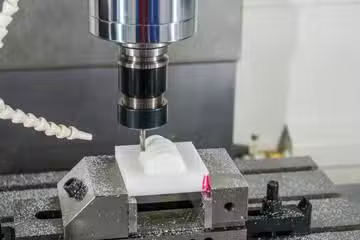
Jigs and fixtures find widespread application due to their numerous benefits. Some notable uses include:
- Bulk drilling, reaming, and tapping operations
- Milling, bulk turning, and grinding processes.
- Facilitating the precision machining of contours.
- Mass production of components for the automotive industry.
- Continuous inspection of parts in manufacturing industries.
- Cutting ingots in steel plants.
- Drilling flanges and holes at various angles.
- Utilizing in multi-spindle machining.
- Applications in the refrigeration business.
- Streamlining the assembly process in pump manufacturing.
Designing Effective Jigs and Fixtures
To enhance the overall functionality of jigs and fixtures, careful consideration of design elements is crucial. Some important design considerations include:
- Precision Alignment: Ensure that machining fixtures are perfectly aligned for maximum precision. However, be cautious of over-constraint as it may introduce inaccuracies.
- Single-Hand Operation: Design jigs and fixtures to be operable with one hand whenever possible. This allows operators to grip the fixture with one hand while positioning or stabilizing the part with the other.
- Autonomous Operation: Aim to design jigs or fixtures that do not require human intervention to hold the part during secondary operations.
- Simplified Design: Create designs with the fewest steps possible to reduce cycle times and minimize fatigue-inducing repetitive actions.
- Misalignment Recognition: Choose geometries that highlight misalignment faults to contribute to reducing workplace injuries.
- Integration into Manufacturing Process: Consider how the jig or fixture will seamlessly integrate into the entire manufacturing process.
- Material Selection: Carefully select materials for jigs and fixtures. For instance, if the tool is used for multiple parts, opt for durable materials like hardened steel. Alternative materials may include plastic and wood.
Materials Used in Making Jig and Fixture
The choice of material for crafting a jig or fixture hinges on the specific application and the requirements of the machining operation. Here is a list of materials commonly employed in the fabrication of jigs and fixtures:
- Steel (Stainless, Hard, Carbide, Mild, High Speed).
- Cast iron.
- Hardened Aluminum.
- Plastic: Derlin, Nylon, and PC.
- Bronze.
This selection ensures that the material aligns with the intended use and the demands of the machining process.
Conclusion
In the world of CNC manufacturing, the debate between jig vs fixture is a common source of confusion, especially for beginners. This article aims to unravel the intricacies of both tools, exploring their types, uses, and the manufacturing process. By the end of the road, you’ll have a clear understanding of the distinctions between jigs and fixtures and how to leverage them for smoother operations.
For those seeking an experienced manufacturing partner to bring their ideas to fruition, look no further than Zintilion’s CNC machining services. We offer a range of machining operations and prototyping services. Connect with us today to kickstart your project—simply upload your CAD model and gain access to instant quotations. Your manufacturing journey begins here!
FAQ
What is the use of a jig and fixture?
A jig and fixture serve as crucial work-holding devices employed in machining operations to provide support. Their role involves securely, supporting, and accurately positioning a workpiece on various components of a CNC machine. These devices play a pivotal role in enhancing manufacturing operations, promoting smoother processes, improved productivity, and various other advantages.
What are the materials used in making jigs and fixtures?
Materials employed in the fabrication of jigs and fixtures encompass a diverse range, comprising steel variations (stainless, hard, carbide, mild, high speed), cast iron, hardened aluminum, and plastic materials like Delrin, nylon, and PC. Additionally, bronze is among the various materials utilized for these essential manufacturing tools.
What is the difference between a Jig and a fixture?
The primary distinction lies in their core functions. A jig functions by guiding the machine part, such as a cutter, during its operation. In contrast, a fixture is focused on securing, supporting, and stabilizing the workpiece. Notably, with a fixture, the tool remains stationary when the workpiece is in motion. This differs from jigs, where the tool moves along with the workpiece.



